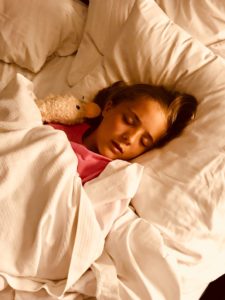 You might believe obstructive sleep apnea (OSA) only affects adults, but children aren’t immune to the breathing disorder. Children’s sleep apnea can be difficult to detect because their symptoms can manifest differently than with adults. Not only can your little one struggle to get the rest they need, but frequent breathing disturbances can affect their physical and mental health. Here’s how to spot the signs of OSA in children, and what can be done to help your child breathe easier.
You might believe obstructive sleep apnea (OSA) only affects adults, but children aren’t immune to the breathing disorder. Children’s sleep apnea can be difficult to detect because their symptoms can manifest differently than with adults. Not only can your little one struggle to get the rest they need, but frequent breathing disturbances can affect their physical and mental health. Here’s how to spot the signs of OSA in children, and what can be done to help your child breathe easier.
What is Pediatric Obstructive Sleep Apnea?
A child’s breathing can be partially or completely blocked by an obstruction in the airway, which can be caused by their tongue or the soft tissues in the back of their mouth collapsing. However, it can be caused by other factors, like large tonsils or adenoids.
No matter the reason, your child can stop breathing frequently throughout the night. Each event depletes their body of oxygen and interrupts their sleep cycle. Daytime sleepiness can lead to behavioral problems and many other complications, including:
- Chronic snoring
- Pauses in breathing
- Restless Sleep
- Snorting, choking, or coughing while sleeping
- Mouth breathing
- Nighttime sweating
- Bedwetting
- Sleep terrors
Signs of sleep apnea don’t just occur at night. You may also notice other changes caused by sleep disturbances, including:
- Poor school performance
- Difficulty paying attention
- Learning problems
- Behavioral problems
- Poor weight gain
- Hyperactivity
If your child is constantly waking up feeling tired or has had behavioral changes, it might be time to speak with their doctor about a sleep study. Pediatric OSA can have serious consequences, including heart problems, failure to grow, and death.
Treating Pediatric Sleep Apnea
If a sleep study confirms a diagnosis, your child’s doctor may recommend treatment. Some children will be monitored for changes while others will need intervention, like removing the tonsils or adenoids. With obesity linked to sleep apnea in children, a healthy diet and regular exercise can improve their symptoms. Nasal steroids may be recommended to keep their airway open.
If changes at home aren’t enough, your child may need a CPAP, which is a machine that delivers a steady stream of air pressure to prevent pauses in breathing. An oral appliance can also be used to reposition your child’s tongue or jaw to prevent them from blocking the airway. It’s a comfortable, effective solution for mild-to-moderate OSA.
A sleep apnea diagnosis can be stressful, but there’s no need to worry. The condition is easy to control and manage with the right treatment plan. With sleep apnea therapy, your child will soon be breathing better, so both you and your little one can get a good night’s rest.
About Dr. Prachi D. Shah
Dr. Shah achieved her dental degree from the New York University College of Dentistry and has completed advanced education in pediatric dentistry, orthodontics, and sleep medicine. As a mother, she understands the compassionate care young patients need. If your child requires treatment for sleep apnea, contact our office today for an appointment.
